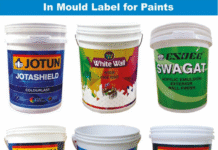A little over a year ago, Mumbai-based labelling solutions provider Mudrika Labels inaugurated its state-of-the-art new facility in Vasai area of north Mumbai. Mudrika has come a long way, especially in the last decade, under the dynamic leadership of three brothers Manish Desai, Vipul Desai and Sandip Kadakia. The new 50,000 square foot plant, which was inaugurated by Gallus’ Karin and Ferdinand Ruesch on 7 March 2016, has altogether 11 flexo presses, six of them being from Gallus, and one gravure press. The Vasai plant consolidates the label business under one roof. Before moving to the new plant, Mudrika’s flexo and gravure operations were based out of two different facilities in Vasai. It was in 2015 that the management began the process of consolidation.
Now, the next phase of investments has begun for both Mudrika Labels and Mudrika Sang Bong Foil, which is a joint venture company that manufactures heat transfer films, in-mold labels, insert films, etc. in India.
New investment phase
For the Mudrika labels division, the management has decided to go for another flexo press which will be installed during the current financial year.
“We have decided to bring in another flexo press this year. This will have a bigger width, most likely more than 400 mm. Also, it will be minimum 10-color with fully loaded features. The LC will be generated during the current financial year. However, when the actual installation happens will depend on how fast the manufacturer can supply the press,” says Manish Desai, one of the directors of Mudrika Labels. The make of the press has not been decided yet but a final decision is expected in one or two months.
Once the new press is in place, the total converting capacity of Mudrika Labels will go up from 9 lakh square meters to 12 lakh square meters per month.
For the labels division, Mudrika will also be buying 100% detection system this year, taking the total to five. Desai informs that the aim is to cover everything with 100% detection system in the coming years given that customers now demand for such a system.
In the Mudrika Sang Bong division, a brand new 11-color rotogravure press will be added to the shop floor along with a metallizing plant. The Mudrika Sang Bong plant will shift from Vasai to Bhillad in Gujarat post the installation of the new gravure press and metallizing plant in a year’s time.
Looking beyond self-adhesive labels
Mudrika is among the top five players in the label industry. Now the company has plans to diversify beyond the regular self-adhesive labels and into more value-added products.
“The narrow web industry has become highly competitive. Until a few years ago, the competition was healthy but now it has become highly commoditized. The costs are rising, while there is pressure on margins. So, we have decided to move beyond the self-adhesive labels to more value-added and specialty products,” Desai explains. The focus area for the company would be shrink sleeves, stand-up pouches and premium self-adhesive labels.
“The flexo press that will be installed soon will be dedicated to value-added applications. And from now on, any further investments that will take place at Mudrika will be from the point of view of value-added and premium products and not just self-adhesive labels,” Desai says.











